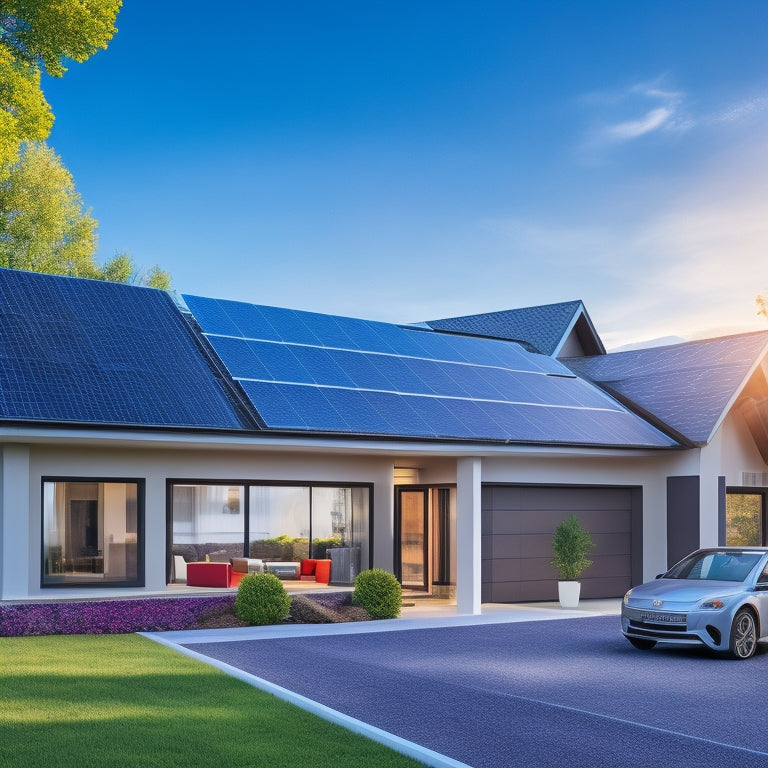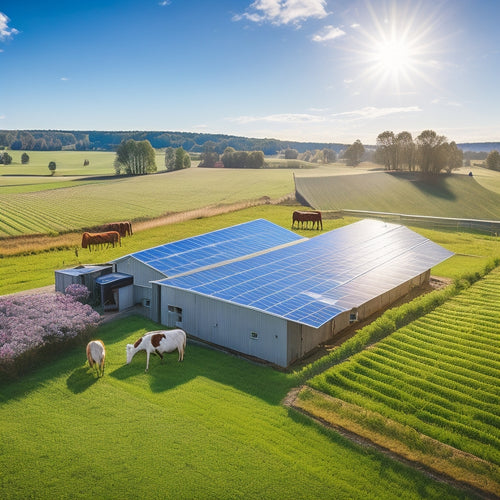
5 Best Home Battery Storage Installation Tips
Share
When installing a home battery storage system, you need to get it right the first time to guarantee peak performance, safety, and longevity. Start by evaluating your home energy needs, considering factors like energy consumption patterns, appliance usage, and HVAC systems. Then, choose the right battery type based on your energy needs, budget, and available space. Confirm a safe installation by following safety regulations and hiring licensed electricians. Maximize your system configuration by sizing it correctly and configuring settings for peak energy conversion. Finally, regularly monitor performance metrics and schedule maintenance to extend battery life.
Key Takeaways
- Conduct a thorough load analysis to identify energy consumption patterns and size your battery bank accordingly.
- Choose the right battery type based on energy needs, budget, and available installation space, considering factors like energy density and lifespan.
- Ensure safe installation practices by hiring licensed electricians, following manufacturer's instructions, and taking necessary precautions to mitigate hazards.
- Optimize system configuration by focusing on system sizing, inverter compatibility, and preventing oversizing or undersizing to maintain performance and lifespan.
- Regularly monitor performance metrics, schedule routine maintenance, and update software to ensure optimal performance and efficiency of your home battery storage system.
Assessing Home Energy Needs
You need to determine how much energy your home consumes to properly size a home battery storage system. This involves conducting a thorough load analysis to identify your energy consumption patterns.
Start by reviewing your past utility bills to understand your average daily energy usage. Next, identify the specific appliances and devices that consume the most energy.
Take into account factors like the number of occupants, lighting, and HVAC systems. It's important to take into account the battery performance metrics, such as capacity and efficiency, to guarantee the system meets your energy needs.
A detailed load analysis will help you pinpoint the peak demand periods and overall energy requirements. This information is vital in selecting the right battery storage system that meets your energy needs.
Choosing Right Battery Type
Several key factors must be considered when selecting the right battery type for your home battery storage system.
You'll want to think about your energy needs, budget, and available space. Lithium-ion batteries are a popular choice due to their high energy density, long lifespan, and low maintenance. However, they come at a higher upfront cost.
Lead acid batteries, on the other hand, are more affordable but heavier, larger, and require more maintenance. When evaluating options, consider reliable brands like Trojan Battery, which offers high temperature tolerance and proven reliability in demanding applications.
Additionally, think about the depth of discharge (DOD), round-trip efficiency, and cycle life of each battery type. You should also consider the manufacturer's warranty, certifications, and customer support.
Ensuring Safe Installation Practices
With your home battery storage system's battery type selected, it's now vital to focus on guaranteeing safe installation practices.
You must adhere to relevant safety regulations to avoid electrical shock, fire hazards, and other risks. It's important to hire licensed electricians experienced in solar installations to guarantee safe and code-compliant installations.
Invest in high-quality installation tools, such as insulated hand tools and personal protective equipment, to guarantee a safe working environment. Confirm you have a thorough understanding of the installation process and battery handling procedures.
Always follow the manufacturer's instructions and guidelines for safe installation, operation, and maintenance.
It's also significant to identify potential hazards, such as poor ventilation or proximity to flammable materials, and take necessary precautions to mitigate them.
Optimizing System Configuration
In tandem with guaranteeing safe installation practices, optimizing system configuration is essential to maximizing the performance and efficiency of your home battery storage system.
You'll want to focus on system sizing, verifying that your battery bank is correctly sized for your energy needs and inverter capabilities. Proper system sizing will prevent oversizing or undersizing, which can lead to reduced performance and lifespan.
Additionally, you'll need to ascertain inverter compatibility with your battery type and system requirements. A compatible inverter will efficiently convert DC power from your batteries to AC power for your home, while an incompatible one can lead to energy loss and system failure.
Monitoring Performance Post-Install
Once your home battery storage system is up and running, you'll want to keep a close eye on its performance to confirm it's meeting your energy needs and operating at peak efficiency.
You should regularly review key performance metrics, such as state of charge, depth of discharge, and round-trip efficiency. This data will help you identify areas for improvement and guarantee your system is operating within the manufacturer's specifications.
Additionally, regular system maintenance is essential to prevent issues and prolong the lifespan of your batteries. Schedule routine checks to inspect connections, clean the system, and update software to achieve optimal performance.
Frequently Asked Questions
Can I Install a Home Battery Storage System Myself?
You can attempt to install a home battery storage system yourself, but be aware of essential DIY considerations, such as ensuring electrical compatibility and proper ventilation, and take necessary safety precautions to avoid electrical shock or fire hazards.
How Long Does a Typical Battery Installation Take?
You'll find that the installation process typically takes 2-5 days, depending on the complexity of the system and battery types, such as lithium-ion or lead-acid, with a professional team working efficiently to get your home battery storage up and running.
Will My Home Battery Storage System Work During a Blackout?
When the lights go out, you'll be the guiding light of hope in the dark, thanks to your home battery storage system, which will seamlessly kick in during a blackout, ensuring blackout preparedness and battery reliability, giving you peace of mind.
Are There Any Government Incentives for Home Battery Storage?
You'll be pleased to know that, yes, there are government incentives for home battery storage. Currently, you can claim a tax credit of up to 26% of the total cost, promoting energy efficiency and reducing your carbon footprint.
Can I Add More Batteries to My System in the Future?
As you commence this energy-saving expedition, you'll be pleased to know that you can easily scale up your system, adding more batteries to increase your battery capacity as your needs evolve, making future expansion a breeze.
Related Posts
-

What Do I Need to Know About Farm Solar Panels
When considering farm solar panels, you need to assess costs, benefits, and technical specifics. Initial investment c...
-

Top-Rated Home Solar Power Kits for Achieving Energy Independence
Top-rated home solar power kits enable you to achieve energy independence by greatly cutting your energy costs. You c...
-

High-Efficiency Solar Battery Chargers for Remote Areas
High-efficiency solar battery chargers are essential for your off-grid energy needs in remote areas. They maximize en...


